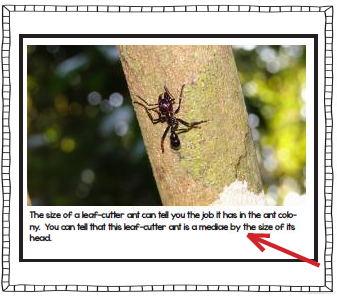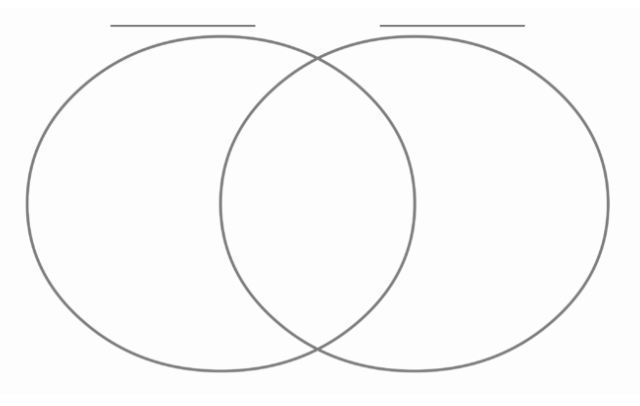What is the setting of a story?
Where and when the story takes place
Define both cause and effect.
Cause is why something happens. Effect is what happens because of it.
Example: If it rains (cause), the game gets canceled (effect).
What do we call a fiction story that is made up but could actually happen in life?
Realistic Fiction
Name this text feature:

Caption
What do we call what a character wants or what makes them act a certain way?
Character Motivation
What do we call the words that describe what kind of person a character is?
Character Traits
What text structure is used when a text is written in a series of steps or events that happen in order?
Sequence or Chronological Order
What do we call a story that is based on real events but told in the style of a narrative or story?
Narrative Nonfiction
Why do some nonfiction articles have bold print or highlighting?
Bold print or highlighting is used to show important words or ideas. These features help readers notice key vocabulary or facts that they should remember.
When writing about the main idea of an article, what do you use to support your thinking?
Text evidence
What do we call the lesson that a character learns and can be applied to other stories?
Theme
Identify the text structure:
Penguins are well-adapted birds that survive in cold environments. They have thick blubber and waterproof feathers that keep them warm in freezing temperatures. Their wings work like flippers, helping them swim quickly through icy water to catch fish, squid, and krill. Most penguins live in places like Antarctica, where they huddle together in groups to stay warm and protect themselves from the cold wind.
Description
What's the difference between realistic fiction and historical fiction?
Realistic fiction is a made-up story that could happen in the present day.
Historical fiction is also made-up, but it takes place in the past and includes real historical settings, events, or people.
What's the difference between an index and glossary?
An index is a list of topics and page numbers, found at the end of a book. It helps you quickly find where something is in the text.
A glossary is like a mini dictionary, also usually at the end of a book. It gives definitions for important words used in the text.
Example:
Use the index to find what page “volcanoes” are on.
Use the glossary to find out what “lava” means.
What author's technique is being used when objects or symbols are repeated throughout a story to represent a deeper meaning?
Hint: Think about the cage in The Tiger Rising or Ellen's necklace in Number the Stars.
Symbolism
How can you identify character traits in a story?
Paying attention to how a character acts, thinks, feels, and talks.
What is an example of a topic that a problem and solution article might be about?
An article about plastic pollution in the ocean and ways people are working to clean it up.
What makes a poem different from other types of writing?
A poem is different because it’s written in stanzas instead of paragraphs. Poems often use rhyme, rhythm, and line breaks to express feelings or ideas in a creative way.
What's the difference between a title, heading, and subheading?
Title – Tells the name of the whole text. It gives the reader a big idea of what the entire article or book is about. Example: “All About Sharks”
Heading – Tells what a section of the text is about. It helps organize the text into parts. Example: “Where Sharks Live”
Subheading – Gives more detail under a heading. It breaks the section into smaller parts and helps readers find specific information. Example: “Sharks in the Pacific Ocean”
What do we call the perspective from which a story is told, such as first person or third person?
Point of View
Name two story elements that work together to help the reader better understand the story. Explain how they connect.
Possible answers:
Character and problem – The way a character handles a problem shows their traits.
Setting and problem – The setting can create or influence the main problem.
Theme and character relationships – Relationships between characters often reveal the story’s message.
Problem and theme – The way the characters handle the problem can help show the theme.
What type of organizer is this? What text structure do we use it for? What does it help us do?

This is a Venn diagram.
We use it to take notes for the compare and contrast text structure. It helps organize similarities (in the middle) and differences (on the sides) between two topics.
How can understanding the genre of a text help you analyze the author’s purpose and message?
Knowing the genre helps you understand why the author wrote the text and what techniques they might use to share their message.
For example, a historical fiction novel might use real events from the past to highlight a social issue, show what life was like during a certain time, or teach a lesson through fictional characters.
Name three ways that a diagram can help a non fiction reader.
A diagram helps the reader understand information by showing it in a clear, visual way.
It can explain how something works.
It can show the parts of something.
It can organize facts so they’re easier to understand.
What is author’s purpose? Give one fiction and one nonfiction example and explain why.
The author’s purpose is the reason they wrote the text.
In Save Me a Seat, the author’s purpose is to help readers understand what it feels like to be new or misunderstood. The story uses characters like Ravi and Joe to show how people from different backgrounds can face challenges and find friendship.
In the article Katherine Johnson, the author’s purpose is to inform readers about her contributions to space exploration and the challenges she overcame as a Black female mathematician at NASA.